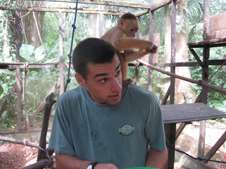Learning sustainability from the rainforest

(PhysOrg.com) -- Co-op in Peruvian ecological reserve teaches biology major some unforgettable lessons about caring for the environment at home.
If he wasn’t caring for endangered spider monkeys, junior biology major Zack Kennedy was securing turtle eggs against poachers during a co-op last fall in the Taricaya Ecological Reserve in Peru’s Amazonian rainforest.
The experiential learning opportunity, which also required him to grow his own food and live without electricity, sparked his interest in environmental sustainability. It showed him that the forest is one living organism — one in which each plant, animal and body of water is crucial to the health of the whole.
One of his projects involved rehabilitating spider monkeys that had been domesticated by owners who acquired them through the illegal pet-trading industry. The privately owned ecological reserve took possession of the monkeys from the local government, which had confiscated the animals from the owners. A few of the monkeys had rope burns on their bodies from being tied to trees; others were afraid to socialize with their primate friends.
He checked the animals for diseases, boosted their health by feeding them locally grown papaya, bananas, carrots and apples, and helped them become re-acclimated to their natural habitat.
The reserve plans to release half a dozen spider monkeys back into the local forest by late April. By the end of his co-op, said Kennedy, “they were a lot bigger, there were no more scars around their chests and they were playing and being social with the other monkeys.”
Kennedy also collected turtle eggs and incubated them on private beaches so poachers couldn’t get their hands on them. When they hatched, he marked them and released them into the wild. Over the years, the practice has paid off: an observational survey of the turtles in the spring of 2009 indicated that the turtles are thriving in the sweltering heat of the rainforest.
Kennedy lived a few hours outside of Puerto Maldonado, a city in Southeastern Peru, shacking up in a bungalow made of wood and mosquito netting. He pumped water from a nearby creek, ate homegrown pineapples, tomatoes and avocados, and raised mahogany trees, one of the most valuable — and endangered — tree species in the Amazon basin.
It didn’t take him long to get accustomed to the Amazonian lifestyle. “I felt at home within a few days,” he says. “We don’t necessarily need all the stuff that we have.”
The experience shaped his current outlook on the importance of sustainable living and inspired him to pursue a career in the field upon his graduation next year. “I bought a bicycle, I made furniture from old wood and I have plans to compost my own trash,” Kennedy says. “Little things like that add up.”
He credits Northeastern for connecting him with Projects Abroad, an organization that organizes overseas volunteer work. “I can’t thank Northeastern enough for giving me this opportunity,” he says. “I don’t know where else I would have been able to do this.”
Provided by Northeastern University

















